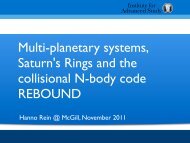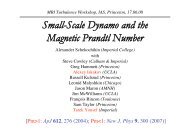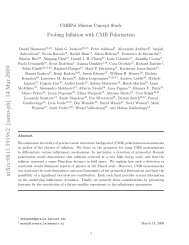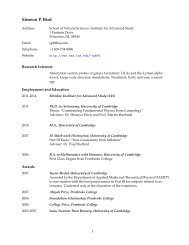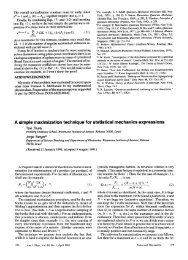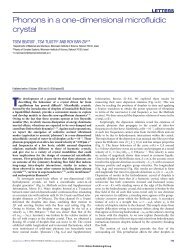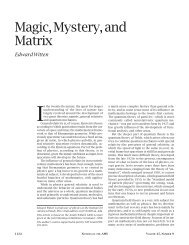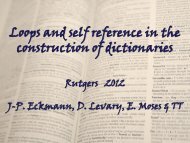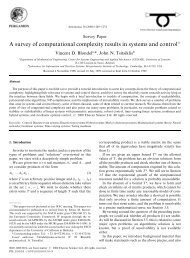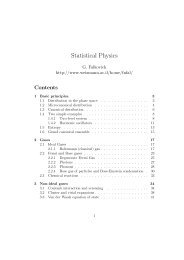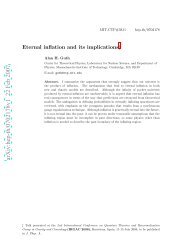Introduction to String Theory and D–Branes - School of Natural ...
Introduction to String Theory and D–Branes - School of Natural ...
Introduction to String Theory and D–Branes - School of Natural ...
You also want an ePaper? Increase the reach of your titles
YUMPU automatically turns print PDFs into web optimized ePapers that Google loves.
9.7 Further Non–Abelian Extensions . . . . . . . . . . . . . . . . . . . . . . . . . . . . . . . . . . 120<br />
9.8 Further Curvature Couplings . . . . . . . . . . . . . . . . . . . . . . . . . . . . . . . . . . . . 121<br />
10 Multiple <strong>D–Branes</strong> 122<br />
10.1 Dp <strong>and</strong> Dp ′ From Boundary Conditions . . . . . . . . . . . . . . . . . . . . . . . . . . . . . . 122<br />
10.2 The BPS Bound for the Dp–Dp ′ System . . . . . . . . . . . . . . . . . . . . . . . . . . . . . . 124<br />
10.3 Bound States <strong>of</strong> Fundamental <strong>String</strong>s <strong>and</strong> D–<strong>String</strong>s . . . . . . . . . . . . . . . . . . . . . . . 125<br />
10.4 The Three–<strong>String</strong> Junction . . . . . . . . . . . . . . . . . . . . . . . . . . . . . . . . . . . . . 126<br />
10.5 Aspects <strong>of</strong> D–Brane Bound States . . . . . . . . . . . . . . . . . . . . . . . . . . . . . . . . . 128<br />
10.5.1 0–0 bound states . . . . . . . . . . . . . . . . . . . . . . . . . . . . . . . . . . . . . . . 128<br />
10.5.2 0–2 bound states . . . . . . . . . . . . . . . . . . . . . . . . . . . . . . . . . . . . . . . 128<br />
10.5.3 0–4 bound states . . . . . . . . . . . . . . . . . . . . . . . . . . . . . . . . . . . . . . . 128<br />
10.5.4 0–6 bound states . . . . . . . . . . . . . . . . . . . . . . . . . . . . . . . . . . . . . . . 129<br />
10.5.5 0–8 bound states . . . . . . . . . . . . . . . . . . . . . . . . . . . . . . . . . . . . . . . 129<br />
11 <strong>String</strong>s at Strong Coupling 129<br />
11.1 Type IIB/Type IIB Duality . . . . . . . . . . . . . . . . . . . . . . . . . . . . . . . . . . . . . 129<br />
11.1.1 D1–Brane Collective Coordinates . . . . . . . . . . . . . . . . . . . . . . . . . . . . . 129<br />
11.1.2 S–Duality <strong>and</strong> SL(2, Z) . . . . . . . . . . . . . . . . . . . . . . . . . . . . . . . . . . . 131<br />
11.2 SO(32) Type I/Heterotic Duality . . . . . . . . . . . . . . . . . . . . . . . . . . . . . . . . . . 131<br />
11.2.1 D1–Brane Collective Coordinates . . . . . . . . . . . . . . . . . . . . . . . . . . . . . 131<br />
11.3 Dual Branes from 10D <strong>String</strong>–<strong>String</strong> Duality . . . . . . . . . . . . . . . . . . . . . . . . . . . 132<br />
11.3.1 The Heterotic NS–Fivebrane . . . . . . . . . . . . . . . . . . . . . . . . . . . . . . . . 133<br />
11.3.2 The Type IIA <strong>and</strong> Type IIB NS5–brane . . . . . . . . . . . . . . . . . . . . . . . . . . 133<br />
11.4 Type IIA/M–<strong>Theory</strong> Duality . . . . . . . . . . . . . . . . . . . . . . . . . . . . . . . . . . . . 135<br />
11.4.1 A Closer Look at D0–branes . . . . . . . . . . . . . . . . . . . . . . . . . . . . . . . . 135<br />
11.4.2 Eleven Dimensional Supergravity . . . . . . . . . . . . . . . . . . . . . . . . . . . . . 136<br />
11.5 E8 × E8 Heterotic <strong>String</strong>/M–<strong>Theory</strong> Duality . . . . . . . . . . . . . . . . . . . . . . . . . . . 137<br />
11.6 M2–branes <strong>and</strong> M5–branes . . . . . . . . . . . . . . . . . . . . . . . . . . . . . . . . . . . . . 138<br />
11.6.1 From <strong>D–Branes</strong> <strong>and</strong> NS5–branes <strong>to</strong> M–Branes <strong>and</strong> Back . . . . . . . . . . . . . . . . 139<br />
11.7 U–Duality . . . . . . . . . . . . . . . . . . . . . . . . . . . . . . . . . . . . . . . . . . . . . . . 139<br />
11.7.1 Type II <strong>String</strong>s on T 5 <strong>and</strong> E 6(6) . . . . . . . . . . . . . . . . . . . . . . . . . . . . . . 139<br />
12 Concluding Remarks 141<br />
References 141<br />
1 Introduc<strong>to</strong>ry Remarks<br />
These lectures are intended <strong>to</strong> serve as an introduction <strong>to</strong> some <strong>of</strong> the basic techniques, language <strong>and</strong> concepts<br />
in string theory <strong>and</strong> D–branes. by no stretch <strong>of</strong> the imagination will you learn everything about these <strong>to</strong>pics<br />
from these notes. You should be able <strong>to</strong> use them <strong>to</strong> get a good sense for how things work, <strong>and</strong> this will<br />
allow you <strong>to</strong> underst<strong>and</strong> the issues which are discussed in the other lecture courses in this school, which will<br />
assume a knowledge <strong>of</strong> basic string theory, <strong>and</strong> some previous experience with some <strong>of</strong> the “post–Second–<br />
Revolution” ideas. Once you get <strong>to</strong> a certain stage, the notes will need <strong>to</strong> be supplemented with more careful<br />
treatments <strong>of</strong> the technology, <strong>and</strong> you will be curious <strong>to</strong> know more about some <strong>of</strong> the <strong>to</strong>pics <strong>and</strong> further<br />
applications that I did not have time or space <strong>to</strong> cover here. I recommend the excellent text <strong>of</strong> Polchinski[1],<br />
<strong>and</strong> also that <strong>of</strong> Green, Schwarz <strong>and</strong> Witten[2], which is still a brilliant text for many aspects <strong>of</strong> the subject.<br />
You might want <strong>to</strong> consult the recent book listed in ref.[4], in order <strong>to</strong> learn more about D–branes <strong>and</strong><br />
4



